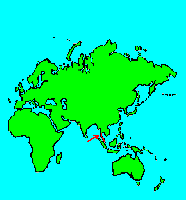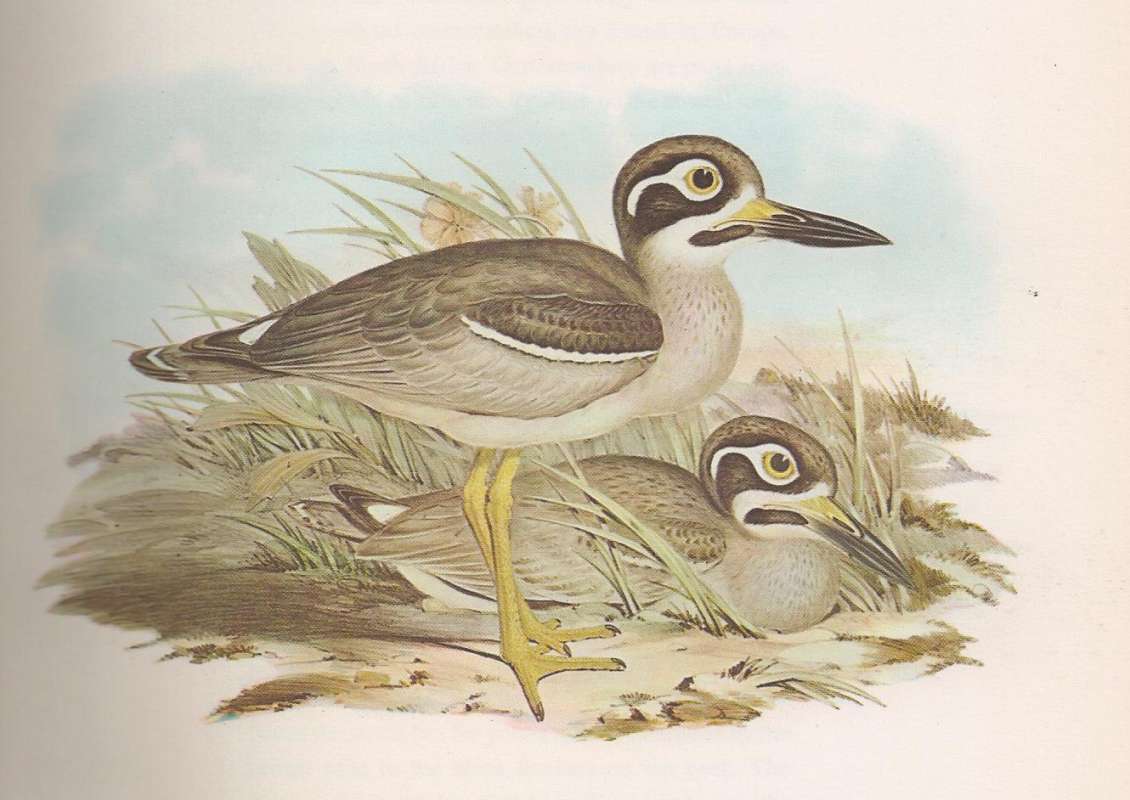SPECIES INFO
Bush thick-knee stone curlew or beach thick-knee stone curlew (Burhinus magnirostris to Esacus magnirostris) is found in wooded areas in Australia. This is also found on Tasmania. This is also found from Malaysia east into the Philippines and south through much of Indonesia and east to New Guinea, and the Solomon Islands.
This 21-24 inch stone curlew has longer legs than most other member of the genus. This life form is also darker than the other member of the genus. The pale breast can be marked with short black vertical streaks. This species has a gray breast that is divided from the neck with a white bordered black band. Most of the bird is brown, but there are white streaks on the brown wings that show when the bird is standing. The face is dark, but there is a white bar over the eye that extends somewhat down to the neck.
Although this species has a wide range, it appears scarce to rare everywhere.
There are no subspecies.The stone curlew genus (Esacus) contains two species. Some scientists place the members of this genus into the genus Burhinus. However, Robson in his book on the birds of SE Asia (2000) retains the two species in the genus Esacus. We note that it is not the technical papers that drive taxonomic changes, but the publishing authors that decide which papers are valid and worthwhile!
The overall range of the first species in this genus is from Iran east to India and south east Asia. The second species is found from islands near Malaysia east to New Guinea, Australia, and islands further east.
These birds can reach from about 20 to 22 inches in length. Both species have pale breasts and a white stripe over the eye.
Stone Curlews (Family Burhinidae) are a group of nine species that are generally found in open, stony areas near water. Their thick knee joints help identify this group.
Shorebirds (Order Charadriformes) are a group of 305 species of worldwide birds. While good fliers, they are much observed feeding along seashores and in the vicinity of inland bodies of water. Seagulls and sandpipers are typical representatives of this order.
There are many different families herein, and most authors end up with about 18 different families. Other groups included herein include the plovers, curlews, coursers, oyster catchers, jacanas, terns, phalaropes, plovers, stilts and avocets, skimmers, snipes, jaegers, and auks and puffins.
Aves contains about 8,650 different species of living birds known to science. Each year about one new species is discovered in some remote rain forest or remote island. In addition, scientists have been raising many subspecies to full species status which may raise the species count to 10,000. Birdlife recognizes 10,027 species as of 2011.
However, each year about one species goes extinct. The rate of extinction is increasing, and the rate of new discovery is decreasing, so that the number of bird species will soon begin to decline rapidly. Although different taxonomists would organize the birds differently, there are approximately twenty-seven orders of birds. These orders are broken down into about one hundred and fifty-five different families.
Recent research of the genetic structure of some of the shore birds and owls would indicate that the present organization of orders and families should have some modification.
The birds are a worldwide group of animals that are characterized by having the front limbs modified into wings that are used for flying. Perhaps the most unique feature of the birds is the feathers. These feathers are made up of a central support called a quill and a series of small filaments that are hooked together as barbs.
For many years it was believed that Archaeopteryx discovered in Bavaria was the oldest bird from about 150 million years ago. However, in l986, Sankar Chattterjee, a Texas paleontologist, reportedly discovered a bird in the genus Protoavis that lived about 225 million years ago.
When this project was begun in 1978, we used Austin & Singer for bird taxonomy. Since then, we have adopted many changes, but have kept some older concepts that are still found widely in the literature. Recently, we have used Clements and Howard & Moore. Very recently, we have used Monroe and Sibley for the higher taxonomy of the perching birds.
Backboned Animals (Phylum Chordata) are the most advanced group of animals on earth. These animals are characterized by having a spinal cord or backbone. Most members have a clearly defined brain that controls the organism through a spinal cord. Fish, amphibians, reptiles, birds, and mammals are in this phylum.
Currently, some taxonomists believe that the fish should be divided into two groups (sharks and regular fishes) and that there are some other primitive groups in the phylum such as hagfish or lampreys.
Animal Kingdom contains numerous organisms that feed on other animals or plants. Included in the animal kingdom are the lower marine invertebrates such as sponges and corals, the jointed legged animals such as insects and spiders, and the backboned animals such as fish, amphibians, reptiles, birds, and mammals.


